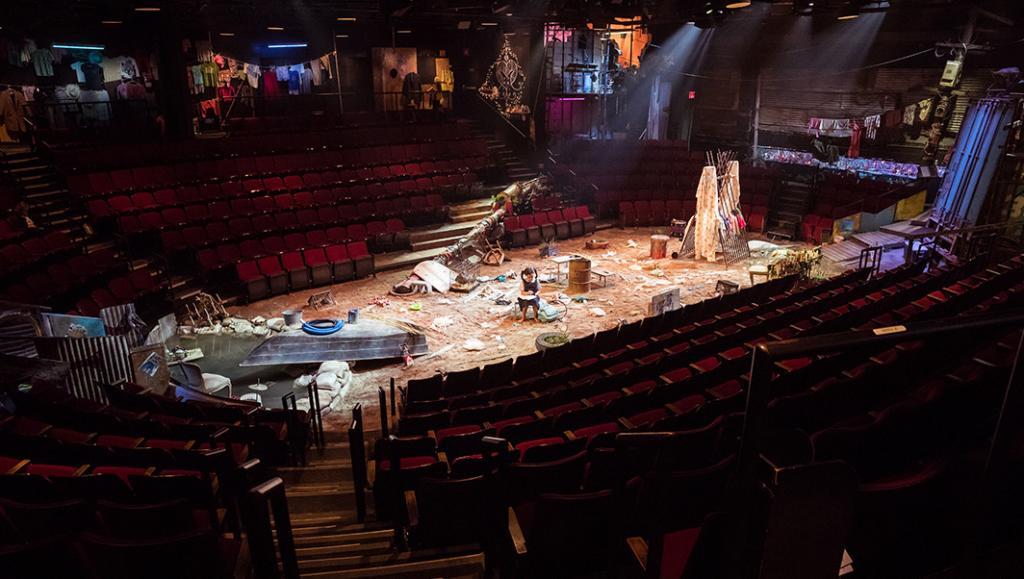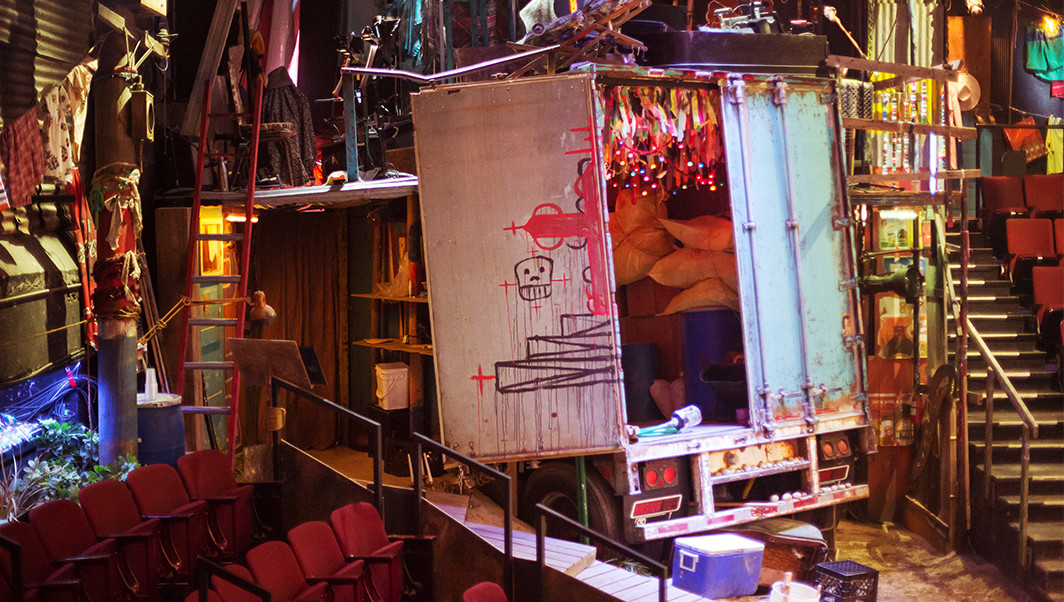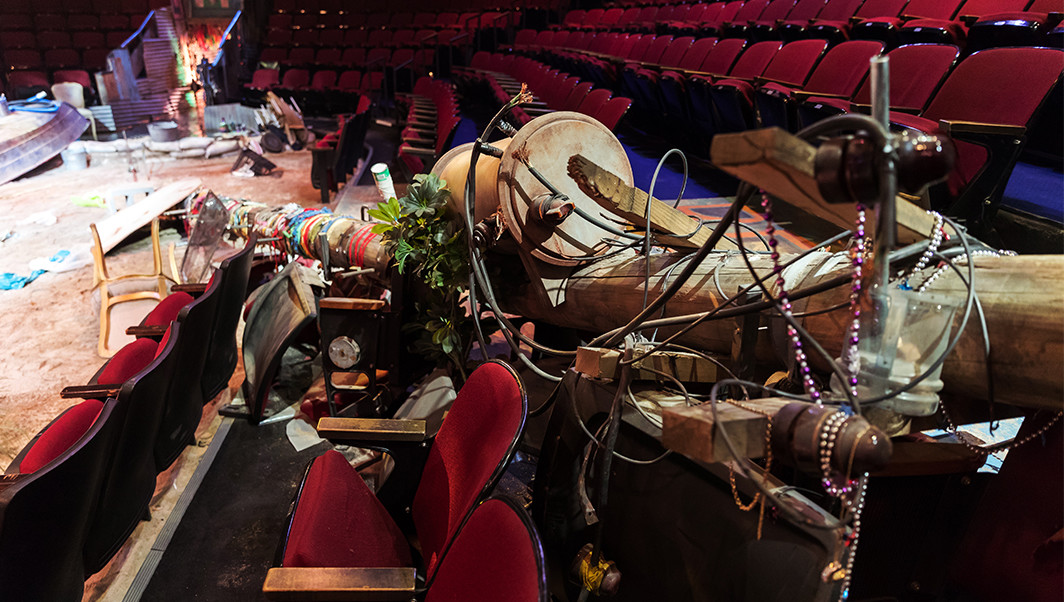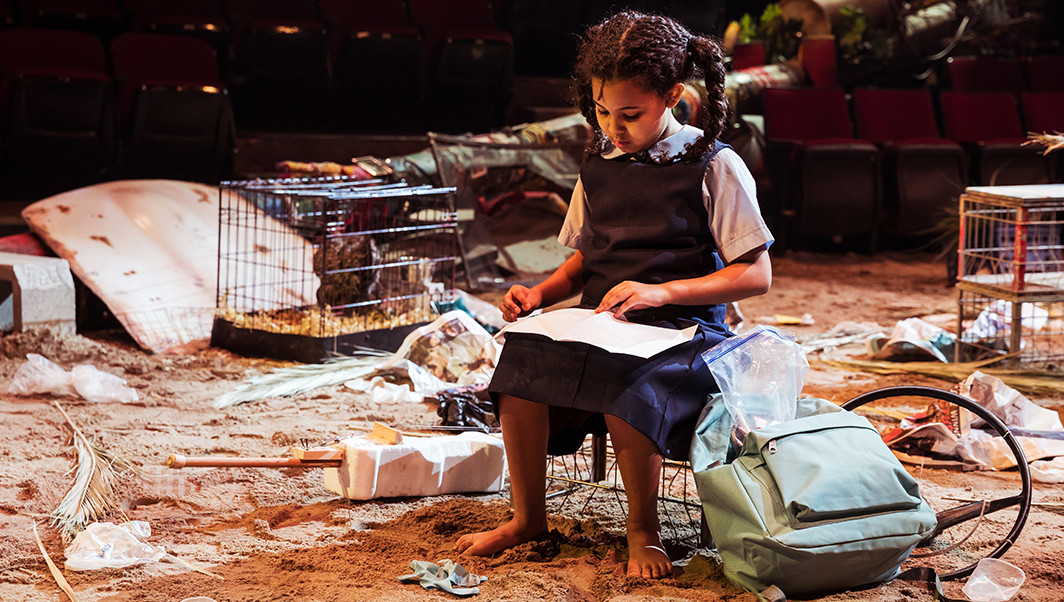Pop Culturalist Chats with Once on This Island Set Designer Dane Laffrey

Dane Laffrey took a Broadway stage and turned it into an island. There is sand. There are live animals. There is a small body of water. There is a truck. There are countless other smaller details that jump out at you, but, no matter what, when you see Once on This Island you will be transported to a vibrant world. And, critics agree: he was nominated for a Tony award for Best Scenic Design of a Musical.
Dane has worked in set design for more than a decade. He’s spearheaded shows like Deaf West Theatre’s Spring Awakening and The Maids. Dane knows what he wants and makes his thoroughly-researched and developed visions come to fruition. So, naturally, we were excited to chat with him about his design process and dive deeper into the Once on This Island world.
PC: What is your design process like when you start a project?
Dane: It has a couple of parts: just downloading my knee-jerk reaction to the piece without going into granular detail, taking stock of it—the things that stuck with me, my feelings about it, my questions about it—and then doing the same thing with the director. Hopefully [I’ll be] catching the director in the same moment and downloading their knee-jerk reactions, too.
Then, beyond that, it is always driven by a lot of visual research. Mining for incredible images that provide context for the world that we’re trying to describe or information about character, the kind of images that feel at one with the piece. That is always constant for me. I can’t have an assistant do it. I have to do it, have an afternoon at the computer and think and download images and see what’s disparate about the things you need to collect. Things like that.
PC: For Once on this Island there was already an idea there so how did that process work? Did you do all that research first and then [director] Michael Arden came to you with his vision, or vice versa since it was very specific?
Dane: It started uniquely early, I would say. Normally, designers are brought on when the production is beginning. You know the show is going to happen so you have a conversation with the designer. But Michael is an old friend and longtime collaborator of mine; he came to me well before that was a reality. He said, “Oh, I have an idea of how I want to do Once on This Island.” At the time, [it] was mostly the idea about the orchestrations, found instruments, and the new sound it was going to have. He said, “I want to pitch that to Lynn [Lynn Ahrens, playwright and lyricist] and Steve [Steve Flaherty, the composer]. I think it would be great if we could also show them some images of the world.” And I was like, “Ok.” Then I started getting into it and was like, “Hold on. Where exactly do we think this piece is set?” The script is not explicit about it, but if you do any amount of looking into it, it’s quite specifically set in Haiti. So we started our research there which is a pretty deep wellspring of very, very powerful imagery. We started from probably a collection of 20 or 30 images that we shared to give them some context of the world before they even agreed to let Michael do this. And then once that happened, we started a process of research. Eventually, we were able to go on a research trip to Port-au-Prince last year for a few days which was really incredible and sort of changed direction for us.
Beyond the research phase, I use a variety of different tools in the design process depending on the nature of the piece. In this case, we were pretty old school about it. For this piece I felt like it needed to be—I hate to use the word collage—an assemblage. We were building an installation in scale so we started with the scale model of the room—Circle in the Square—when it was empty, and then we built a bunch of pieces from the research. There was an early image of an 18-wheeler up a tree that stuck with me, and so, when we started that model process I was like, “I think we need to have the back of a truck. I don’t know where that is going to go, but let’s make that in scale and see.” We built a bunch of makeshift shelter structures. We built rubble, bits of furniture, and milk crates. After almost two weeks of just doing that, we started to put it together and put some foliage and sand in it to see what it formed. It was a pretty organic design process in that respect. I think at the time we were doing that Michael was there every other day to look at it and move it around. You can’t really make work like this without that collaboration.
PC: Is there anything that you had initially thought of for the set that didn’t work out that you wish still could have been incorporated somehow?
Dane: Not really, no. I think the whole process was a gradual stripping away and clarifying. We started with more, and it really was a challenge to curate, redefine, reshape, and remove….it’s still a very maximal space, but it was really more about editing than being forced to cut things we loved. So I don’t have any regrets about anything lost in the shuffle. I think what we ended up with was right and poignant and responsible.
PC: Do you have a portion of the set or a piece of the set that is your favorite?
Dane: I have a couple. I certainly have an affinity with the tractor-trailer truck because it’s huge and outrageous and it’s a real truck. It has been on the road for many thousands of miles. I love its reality. I love the history it brings with it. I love the audacity of it: crashed through a wall in that theater. That’s always felt exciting to me. I also really like our tree—our downed power pole crashed into the audience. [It was] an early impulse in the design that we loved and stuck with. It interrupted the theater space and was a visceral reminder of the devastation of the storm that preceded this story; [it’s] impacting the world that we put in the theater—and the theater itself—and merging those two things. But what it becomes as it’s resurrected at the end of the piece is this wonderful commemorative object. The research foundation for it is the central pole that each vodou temple has. In our case, it’s encrusted with photos of our company’s loved ones who have passed away. It’s like a small granular thing that unless you’re pretty close to it you wouldn’t see that detail, but you can feel that the company has a connection to it. The resurrecting of it [in the show] feels important on a few different levels for them. Figuring out that moment in the piece was challenging: what it means when the heroine of the story transformed into a tree. Certainly, there is no literal way to do that; I’m happy that it ended up being something with so much heart.
PC: This space is like theater in the round without the traditional separation between the audience and the performers. What was the biggest challenge in designing for the space?
Dane: The first one was figuring out how to make it in the round in the way we wanted it to. Technically, what that theater comes with is three sides of seating. It’s kind of a deep thrust space. We knew we always wanted it to be a fundamental in the round experience. Knowing how to do that, how many seats we could fit, and how to echo the shape of the seating back on the opposite side of the room so it felt like a continuation of the space and not something that was added hopefully looks effortless. It was actually pretty challenging. Once you start to readjust how people occupy the space there’s a lot of permitting issues you encounter, and the rules about fire exits change. All the irritatingly technical things felt super important for us to do. Otherwise, it was making sure the space felt as complete as it could; that from each of the almost 700 seats you were having a complete and unique experience. [It would be] an experience that included an exciting big picture and also, depending on where you are, included some smaller pictures that you get because you’re in that particular seat. You know the person across the way can’t see or have that same experience. I think there’s something about that that is super important. I spent a bunch of time in that room; it’s what I did every day for two-and-a-half months to try and populate it.
PC: What was it like seeing the final product and having an audience finally be a part of that world?
Dane: Well that [world] actually was about the audience. It was about the physical bodies in the space; that was the most exciting thing. We worked a long time in that room without the sand—that went in right before we started technical rehearsals—which was weird. The set didn’t fundamentally make sense without the sand so when that went down I was like. “Oh ok! That really makes a difference,” and then cut to three weeks later when we finally had a house of people filling those chairs in. I was like, “This is what it’s supposed to be. This is what it’s supposed to feel like.” But as far as the actual stage, I continued to work on it through the end of first twenty-five previews until they basically kicked me out. [laughs] It was a feeling of not exactly completing it and just having to finish it. I think that’s ok. I think that’s the nature of a Broadway musical in general. It takes so much time and effort and human beings to make any changes. You can never quite finish. At a certain point, you just have to let it go.
PC: Beyond Once on This Island, do you have a dream project? Whether it’s a type of show or medium?
Dane: Yeah, sure. If I’m dreaming, I would like to try a bunch of different mediums. I would be very interested in exploring what it’s like to do my job on film and television. I have questions about whether I would find it satisfying to work in that level of detail or whether I’d find it disheartening because it’s a lot less world-building. It’s a lot less holistic and a lot more at the mercy of the camera. I have questions about that that I yearn to answer. I certainly would love to do more opera which is something I almost never get to do. I think a lot of designers would say that. It’s the dream medium for designers. The scope of the music supports the kind of visual gesture that is large and unique. I have vague dreams of making installation art that seem especially far-fetched at this point since I know nothing about how that world works. I’m excited to diversify my practice.
PC: What inspired you in the first place to go into set design?
Dane: I was a theater kid in junior high and high school and in the community theater, but I was not comfortable with acting. I was frustrated that I wasn’t good at it, but I couldn’t divorce myself from the idea that theater was the one thing I found and felt connected to. [It was] worth challenging myself on figuring out how to be better at. At some point, it occurred to me that design was the best contribution I could make in the goal of being a theater-maker. I think it was a deep, interesting commitment to theater. It’s also just the only thing I have ever done. I have evolved with it, but it continues to be the thing that at the end of the day I deeply love.
Pop Culturalist Speed Round
Guilty pleasure TV show
RuPaul’s Drag Race. I don’t think it’s a guilty pleasure. I think it’s brilliant TV.
Favorite Movie
I’m so bad at favorites. I have a genre. I like World War II movies from the 1960s. I have a strange affinity with those. I have since I was a kid, and I still love them.
Favorite Place You’ve Been
Japan
Place You Most Would Like to Travel To
Russia…actually, kind of the former Soviet Bloc countries.
First Play or Musical You Worked On Professionally
It was a play. I went to school in Australia so it was a play in Sydney called Live Acts on Stage. It was by a person called Michael Gow. It was a little theater called The Griffin.
Person You Would Most Like to Meet Someday
Actually not a person…it’s a dog with a pretty solid Instagram profile called Bart Danzig.
Hidden Talent
I’m a really good cook, but I try not to hide that.
Favorite Childhood Book
Roald Dahl’s The Wonderful Story of Henry Sugar
Song You Sing in the Shower/Karaoke
Any song from the musical I am currently working on—in a way that makes me insane! When you work on a musical, it an unstoppable unending song in your head for the entire duration.
Learn more about Dane Laffrey’s work here. For more information and tickets for Once on This Island, click here.
Photo Credits: Andrew Kluger





Discussion about this post